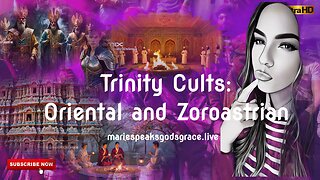Premium Only Content

Hebrew And Jewish Terminology Word Of The Week: Friend – Yedeed/-Ah
Welcome Back Child Of The Most High Living G-D!
Hebrew And Jewish Terminology Word Of The Week: Friend – Yedeed/-Ah, Friendliness- Yakhas Yedeedootee, Friendly- Yedeedootee, Friendship- Yedeedoot
Blog for this Lesson:
https://mariespeaksgodsgrace.live/category/jewish-terminology/
Links used this video:
https://en.wikipedia.org/wiki/History_of_the_Jews_in_Mexico
https://en.wikipedia.org/wiki/Five_Civilized_Tribes
Jews in mexico
Mexico is home to a significant Jewish community, with an estimated 40,000 Jews living in the country. The Jewish presence in Mexico dates back to the early colonial era, with the first Jews arriving in the 16th century. However, it wasn’t until the late 19th and early 20th centuries that a significant wave of Jewish immigration to Mexico occurred.
Early History
The first Jew known to have been in Mexico was Hernando Alonso, a ship’s carpenter who arrived in 1521. He was later burned at the stake in 1528, along with Gonzalo de Morales, who was reportedly his brother. During the colonial period, many Spanish and Portuguese Jews were met with violence and imprisonment, and were threatened with forced conversion.
Immigration and Community Development
After Mexico gained independence in 1821, Jewish life gradually moved into the public eye. In the late 19th and early 20th centuries, a wave of Sephardi, Ashkenazi, and Mizrahi immigrants established a significant presence in Mexico City. Many of these immigrants were refugees fleeing persecution in Europe and the Ottoman Empire.
The first formally established Jewish community in Mexico was the Sociedad de Beneficencia Alianza Monte Sinaí, founded in 1912 to help Jewish immigrants. In 1914, the land for the first Jewish cemetery in Mexico was bought, marking the beginning of the community’s desire to take root in the country.
Native american border schools map
The National Native American Boarding School Healing Coalition has created an interactive map that includes information and locations for all 523 known Indian boarding schools in the United States, as well as known Indian residential schools in Canada. The map is a powerful tool for understanding the complex and often painful history of Native American boarding schools.
Key Features of the Map:
Over 523 known Indian boarding schools in the United States and Canada
Information on each school, including location, dates of operation, and brief descriptions
Ability to filter by state or province
Links to archival records and additional resources
History of Native American Boarding Schools:
Native American boarding schools were established in the United States from the mid-17th to the early 20th centuries with the primary objective of “civilizing” or assimilating Native American children and youth into Anglo-American culture. The schools were often harsh and traumatic for the children who attended them, with many being forced to abandon their languages, cultures, and identities.
Legacy of Native American Boarding Schools:
The legacy of Native American boarding schools is complex and multifaceted. While the schools were intended to “civilize” Native American children, they often resulted in the erasure of Native American cultures and identities. Many Native American communities continue to struggle with the intergenerational trauma caused by the boarding school experience.
Resources:
National Native American Boarding School Healing Coalition: www.nabshc.org
Interactive Map: www.nabshc.org/map
Bureau of Indian Education (BIE) Schools Directory: www.bie.edu/schools
Note: The information provided is based on the search results and may not be exhaustive.
Today’s Community
Today, most Jews in Mexico are descendants of this immigration and still divided by diasporic origin, primarily Yiddish-speaking Ashkenazim and Judaeo-Spanish-speaking Sephardim. The community is insular, with its own religious, social, and cultural institutions, mostly in Mexico City, Monterrey, and Guadalajara.
Locations of conquistadors landings in the americas
The Spanish conquistadors, led by Hernán Cortés, arrived in the Americas in 1519, marking the beginning of the Spanish colonization of the New World. Here are some of the notable locations where the conquistadors landed and established their presence:
Mexico: Cortés and his men landed in Veracruz, Mexico, in 1519, and later conquered the Aztec Empire, led by Moctezuma II.
Central America: The conquistadors expanded their rule to northern Central America, including present-day Guatemala, Honduras, El Salvador, and Nicaragua.
South America: The Spanish conquistadors, led by Francisco Pizarro, conquered the Inca Empire in present-day Peru, and established the city of Lima in 1535.
Florida: Juan Ponce de León landed in Florida in 1513, and the Spanish established several settlements, including St. Augustine, which is now the oldest continuously occupied European-established settlement in the continental United States.
Texas: The Spanish conquistador Álvar Núñez Cabeza de Vaca arrived in Texas in 1528 and established the first Spanish settlement in the region.
California: The Spanish conquistador Juan Rodríguez Cabrillo explored the California coast in 1542-1543, and the Spanish established several missions and settlements in the region.
Caribbean: The Spanish conquistadors established colonies in the Caribbean, including Puerto Rico, which was colonized in 1508, and Cuba, which was colonized in 1511.
These locations were significant not only for the Spanish conquests but also for the cultural and linguistic exchange between the indigenous peoples and the Spanish colonizers, which had a lasting impact on the Americas.
https://pointsofarrival.is.ed.ac.uk/history
https://en.wikipedia.org/wiki/History_of_the_Jews_in_Scotland
____________________________________
Ooooh, how I have missed our talks and time together. Although, the time off may not have been long in actual sense, for me time seem to drag on until well last week! Then I felt the rush of excitement that comes with every beginning of a new season.
Thank you to those returning, it has been a journey especially with all the updates and changes that tend to happen in the current, but not permanent (B’H) climate the world currently is in. Also, thank you to the new subscribers and followers. I do hope you enjoy the new season and whatever stage one is, please remember we all have to start somewhere and whenever in doubt, dismay, or wonder, ask G-d. Most importantly……….
#ThankYouHaShem
My G-d, my Creator, my Father, and the True Love of my Life!
Please know that everyone will truly be in our prayers.
And you all are loved and missed.
with love..,
Marie
-
 4:07:46
4:07:46
Rheena Velia Speaks G-D's Grace
3 months agoFinal Video of Season 7 Trinity Cults: Oriental and Zoroastrian
1461 -
 LIVE
LIVE
Pop Culture Crisis
1 hour agoColdplay Exposes CHEATERS! Israel Boycotts SUPERMAN, Justin Bieber Mooching Off Hailey | Ep. 879
410 watching -
 LIVE
LIVE
charwinslow
4 hours agofinishing Fire Emblem: Blazing Blade - HECTOR HARD MODE!
94 watching -
 16:30
16:30
Brad Polumbo
6 hours agoCreepy “trans” star Lilly Tino has learned NOTHING! | NORMAL GAYS react
1.54K3 -
 8:00
8:00
Freedom Frontline
2 hours agoJake Tapper Just HUMILIATED Tim Walz on CNN With Simple Questions
1.59K2 -
 1:40:43
1:40:43
Benny Johnson
3 hours ago🚨White House Press Briefing LIVE Right Now: Karoline Leavitt Reacting to Massive New Trump News
36.8K35 -
 1:20:47
1:20:47
Russell Brand
3 hours agoRoyal Cover-Up? The Final Chapter of Diana’s Death - SF616
113K44 -
 3:35:49
3:35:49
Right Side Broadcasting Network
5 hours agoLIVE REPLAY: White House Press Secretary Karoline Leavitt Holds a Press Briefing - 7/17/25
104K31 -
 1:16:33
1:16:33
Nikko Ortiz
3 hours agoBuilding Your Night Rifle
25.4K -
 2:06:45
2:06:45
Side Scrollers Podcast
5 hours agoAstronomer CEO/HR Scandal, NPR/PBS DEFUNDED, Mortal Kombat II Trailer REACTION | Side Scrollers
10.7K1